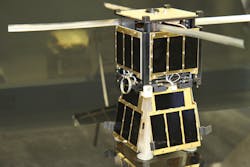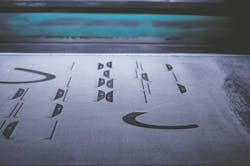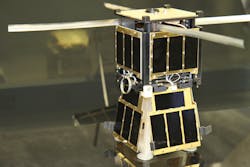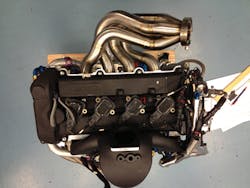Additive manufacturing revolutionizes in space and on the racetrack
Technology simplifies component replacement possibilities
FRANCESCA CUOGHI
CRP USA, founded in 2008, is strategically located in the heart of NASCAR country in North Carolina, and specializes in additive manufacturing and 3D printing applications. The company manufactures on-car and wind-tunnel components for racing teams, and has also taken this expertise to new heights to produce parts for the space (Satellite and CubeSat structures), entertainment, and automotive industries using Windform additive manufacturing (FIGURE 1). Windform materials have made it possible for laser sintering technology to create parts that are highly functional, beautifully finished, and have proven reliability.
Company director of operations Stewart Davis has been working in the field of additive manufacturing for two decades, and the company has expertise in selective laser sintering (SLS) with Windform materials. This technology was developed in the late 1990s by CRP Technology, an Italian company that is part of the CRP Group.
CRP USA serves several industries by offering solutions to companies' needs and problems. "Our customers' challenge becomes our own—this is our motto and this is what we do. We make possible applications that were impossible to pursue, and this is thanks to our Windform materials that have changed the scenario of additive manufacturing," states Davis.
Miniaturized satellite production
The company used Windform materials in additive manufacturing for the Kentucky Space Center to create a CubeSat miniaturized satellite that was successfully launched into orbit (FIGURE 2). The KySat-2 project was carried out by CRP USA, together with Kentucky Space Center, the University of Kentucky, and Morehead State University. In November 2013, the CubeSat KySat-2 was launched into orbit as part of the NASA ElaNa IV mission out of Wallops Flight Facility in Virginia.
There were several 3D-printed components on the KySat-2 that were produced using SLS and Windform materials. The additive manufacturing process involved 3D printing the mounting hardware for the camera system, extensions for the separation switches, clips for holding the antennas in their stowed position, and the mounting bracket for the onboard batteries. The process and the material were critical to achieve the right components for KySat-2. The material combines maximum toughness and robustness, yet produces an extremely light final part that does not impact the overall production weight of the KySat-2 unit. KySat-2's main mission is to be an educational tool and demonstration for the students working on the satellite. It was designed, built, and tested entirely by students and engineers, with most of the subsystems designed in-house.
CRP USA produced five Windform XT 2.0 parts that are incorporated into the deployable solar panels on the KySat-2: the camera annulus, lens cover, deployable extensions, antenna clips, and battery holders. Windform XT 2.0 is a high-performance material filled with carbon fiber that offers maximum mechanical performance for 3D-printed parts. Using SLS and Windform XT 2.0 material, final parts for small productions can easily replace parts that are usually produced with traditional technology or are otherwise not manufacturable.
Utility in motorsports
CRP USA was honored by the North Carolina Motorsports Association for the contributions the company has given to motorsports with Windform 3D printing. Using the technique to produce the intake manifold for Élan Motorsports' DeltaWing racing car is a clear example of how the company has served customer needs. DeltaWing racing cars feature innovative engineering, and CRP USA's additive manufacturing made for a successful combination on- and off-track.
The DeltaWing, introduced in 2010, brought radical innovation and progressing efficiency to the racetrack. When it hit the racetrack, the DeltaWing Racing Cars engineering team pushed the boundaries of conventional design and launched a revolutionary approach in motorsports. But the transition between the 2012 and 2013 season brought significant change to the DeltaWing, as an entirely new operating team, crew, engine, and tire partner made for several new elements as the team took to the track. There was very little time between races to make necessary changes to a car, and the DeltaWing Racing Cars team and Élan Motorsports were faced with having to design a new engine from scratch. So the engineers, working with CRP USA, created an intake manifold utilizing 3D printing technology (FIGURE 3).
Understanding the design and time constraints when it came to the intake manifold, design engineer Christian "Skitter" Yaeger turned to CRP USA to assist on the design and production. Going from nothing but a Mazda head to a new running engine in 81 days, including a 3D-printed intake manifold, was the result of their combined efforts—which led to racing at Sebring in 105 days.
In the redesign of the intake manifold, a high-performance material was required to handle the heat and tension placed on the part. CRP USA introduced Windform SP to the DeltaWing engineering team for consideration. This material has excellent mechanical properties and an added advantage of increased resistance to shocks, vibrations, deformations, and-most importantly-is resistant to absorption of liquids and moisture.
"The packaging constraints required by the location of the engine within the chassis requires some creative design," said Davis. "The runner lengths attach at the base of the plenum and form a complex structure that would be extremely difficult to build without using additive manufacturing. Windform SP's toughness and heat deflection temperature allow the part to be built and then raced in the endurance series. The engine is run under boost, so it sees pressure variation in addition to the vibration, shock, and temperature changes associated with racing."
The resulting component has been campaigned by the team since March 2013, gaining positive results and showing the tremendous potential for utilizing advanced materials technologies in partnership with 3D printing.
"We could not have made this motor happen if we couldn't produce parts directly from CAD files," said Yaeger. "The biggest benefit is being able to print exactly what you need. We have eight odd-shaped ports in the head, and CRP USA was able to match them perfectly, with a knife edge in between."
"With the coupe version, we went slightly less wild and a little more conventional in our design," continued Yaeger. "Over the past two years, the 3D-printed manifolds have covered over 12,000 testing and racing miles, along with six hours per unit running on the dyno."
Prior to the production of the intake manifold, Windform was used on the DeltaWing to produce several different components, including electronics enclosures and transmission seal covers with integrated, pressurized oil feed passages.
These applications illustrate how CRP USA, through Windform additive manufacturing technology, is bringing service excellence to high-performing sectors from space to racetrack, with the aim of building functional free-form superior prototypes. Thanks to a successful production method that has increased the demand in Windform parts from the US market, CRP USA is now working to expand to a 14,000-sq-ft. facility in Mooresville, NC. The move is expected to be completed by the end of the first quarter of 2016.
FRANCESCA CUOGHI([email protected]) is the press office manager for CRP USA, Mooresville, NC, www.crp-usa.net.



